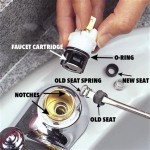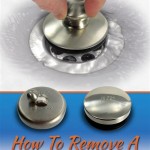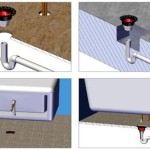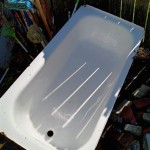How to Remove Old Bathtub Faucet Handles
Removing old bathtub faucet handles can seem like a daunting task, particularly if the handles are corroded, stuck, or of an unfamiliar design. However, with the right tools, patience, and a methodical approach, the process can be successfully navigated. This article provides a comprehensive guide to removing common types of bathtub faucet handles, emphasizing safety and preventative measures to avoid damage to the surrounding fixtures and plumbing.
Identifying the Faucet Handle Type
Before attempting removal, accurately identifying the type of faucet handle is crucial. Different handle designs require different techniques. Common types include:
Set-Screw Handles: These handles are secured to the faucet stem via a small set screw, typically located on the side or underneath the handle. The set screw tightens against the stem, preventing the handle from slipping. This type is one of the easiest to remove once the set screw is located and loosened.
Screw-On Handles: These handles are attached to the faucet stem by a screw, which is often concealed under a decorative cap or button. These caps are typically pressed-fit or lightly threaded. Once the cap is removed, the screw is exposed and can be unscrewed.
Threaded Handles: These handles screw directly onto the faucet stem. They might not have an obvious screw or set screw. Removal involves gripping the handle firmly and rotating it counterclockwise until it detaches.
Push-and-Pull Handles: While less common in bathtubs, these handles operate by pushing or pulling to control the water flow. They usually have a set screw or a hidden screw under a decorative cap.
Ball Handles: These handles, often found on single-handle faucets, utilize a ball joint mechanism. Disassembly typically requires removing a set screw or unscrewing a retaining collar.
Gathering the Necessary Tools and Materials
Having the proper tools on hand will streamline the removal process and minimize the risk of damage. The following is a list of essential tools and materials:
Screwdrivers: A set of screwdrivers, including both flathead and Phillips head, in various sizes is essential. The precise size needed will depend on the type of screw used in the faucet handle.
Allen Wrench Set: An Allen wrench set, also known as a hex key set, is required for removing set screws. Ensure the set includes a range of sizes to match the set screws commonly found in faucet handles.
Penetrating Oil: Penetrating oil, such as WD-40 or Liquid Wrench, helps to loosen corroded screws and handles. Apply generously and allow sufficient time for it to penetrate the corrosion.
Channel-Lock Pliers: Channel-lock pliers, also known as adjustable pliers, provide a firm grip on handles or stems that are difficult to turn. Use caution to avoid scratching the finish.
Adjustable Wrench: An adjustable wrench can be used for larger nuts or components, providing leverage without damaging the surrounding surfaces.
Soft Cloth or Towel: Wrapping a soft cloth or towel around the faucet handle before using pliers or a wrench helps to protect the finish from scratches.
Small Putty Knife or Flathead Screwdriver (thin): These tools can be useful for gently prying off decorative caps or buttons that conceal screws.
Safety Glasses: Wearing safety glasses protects the eyes from debris and splashing water.
Gloves: Wearing gloves provides a better grip and protects hands from dirt, grime, and potential injury.
Plumber's Tape: Plumber's tape, also known as Teflon tape, is used to seal threaded connections when reassembling the faucet.
Step-by-Step Removal Procedures
Once the faucet handle type has been identified and the necessary tools and materials have been gathered, the removal process can begin. The following outlines the procedures for removing different types of faucet handles:
Removing Set-Screw Handles:
1. Locate the set screw. It is usually found on the side or underneath the handle. It can sometimes be hidden in a small recess.
2. Select the appropriate size Allen wrench from the set. Insert it into the set screw. Ensure the wrench fits snugly to avoid stripping the screw head.
3. Turn the Allen wrench counterclockwise to loosen the set screw. Do not remove the set screw completely; just loosen it enough to allow the handle to slide off.
4. Gently pull the handle straight off the faucet stem. If the handle is stuck, apply penetrating oil around the stem and wait a few minutes before trying again. Wiggling the handle gently while pulling can also help to loosen it.
Removing Screw-On Handles:
1. Locate the decorative cap or button that conceals the screw. It is usually on the top or front of the handle.
2. Use a small putty knife or thin flathead screwdriver to gently pry off the cap or button. Be careful not to scratch the handle finish. Some caps may be threaded and require unscrewing.
3. Once the cap is removed, the screw will be exposed. Select the appropriate size screwdriver (flathead or Phillips head) and insert it into the screw.
4. Turn the screwdriver counterclockwise to unscrew the screw. Save the screw for reassembly.
5. Pull the handle straight off the faucet stem. If the handle is stuck, apply penetrating oil and wait before trying again. Gently wiggle the handle while pulling.
Removing Threaded Handles:
1. Grip the handle firmly with your hand. Alternatively, wrap a soft cloth around the handle and use channel-lock pliers for a better grip. Be careful not to damage the finish.
2. Turn the handle counterclockwise. It may require some force to break the initial seal. If the handle is stuck, apply penetrating oil to the threads and allow it to penetrate for a few minutes.
3. Continue turning the handle until it is completely unscrewed from the faucet stem.
Removing Push-and-Pull Handles:
1. Determine if the handle has a set screw or a decorative cap. Follow the appropriate procedure for set-screw handles or screw-on handles, as described above.
2. Once the set screw or screw is removed, the handle should slide off the faucet stem. If it is stuck, apply penetrating oil and gently wiggle the handle while pulling.
Removing Ball Handles:
1. Locate the set screw or retaining collar on the handle or faucet body.
2. If there is a set screw, use the appropriate size Allen wrench to loosen it. If there is a retaining collar, unscrew it by hand or with an adjustable wrench. Wrap a cloth around the collar to protect the finish.
3. Once the set screw or retaining collar is removed, the handle assembly should be able to be disassembled. This may involve removing a ball joint and other components. Take note of the order of the components for reassembly.
Troubleshooting Common Problems
Even with careful execution, certain problems may arise during the removal process. The following offers solutions for common issues:
Stripped Screws: If the head of a screw is stripped, making it impossible to grip with a screwdriver, there are several options. A rubber band placed between the screwdriver and the screw head can sometimes provide enough grip to turn the screw. Alternatively, a screw extractor tool can be used to remove the stripped screw. In severe cases, the handle itself may need to be carefully cut away to access the screw stem.
Corroded Handles: Corrosion can make handles extremely difficult to remove. Generous application of penetrating oil and patience are key. Allow the oil ample time to penetrate the corrosion. Tapping the handle lightly with a hammer (protected by a cloth) can also help break the corrosion bond. Heat from a heat gun (used cautiously) can also expand the metal and loosen the handle.
Broken Handles: If the handle is already broken, it may be difficult to get a good grip. Use channel-lock pliers or an adjustable wrench, wrapped with a cloth, to grip the remaining portion of the handle. Apply penetrating oil and try to turn or pull the handle off the stem. If the stem is also damaged, a plumber may need to be consulted.
Damaged Faucet Stems: Exercise caution when removing handles to avoid damaging the faucet stems. If a stem is bent or broken, the entire faucet assembly may need to be replaced. Avoid excessive force when turning or pulling handles.
Preventative Measures and Tips
To prevent future problems and ensure the longevity of the new faucet handles, the following preventative measures and tips should be considered:
Regular Cleaning: Regularly clean the faucet handles with a mild soap and water solution to prevent the buildup of mineral deposits and corrosion. Avoid using abrasive cleaners, which can damage the finish.
Lubrication: Periodically lubricate the faucet stems with plumber's grease to ensure smooth operation and prevent sticking. This is especially important for threaded handles.
Proper Installation: When installing new faucet handles, ensure that all screws and connections are tightened properly but not over-tightened. Over-tightening can damage the screws or the handle itself.
Using the Right Tools: Always use the correct size and type of tool for the job. Using the wrong tool can damage the faucet handles or the surrounding fixtures.
Applying Plumber's Tape: When reassembling threaded connections, apply plumber's tape to the threads to create a watertight seal. Wrap the tape clockwise around the threads several times.
Turning Off the Water Supply: Before starting any plumbing work, always turn off the water supply to the faucet. This will prevent flooding and potential water damage.

How To Fix A Leaking Bathtub Faucet Diy Family Handyman

How To Replace Bathtub Faucet Handles

How To Fix A Leaking Bathtub Faucet Diy Family Handyman

How To Replace Bathtub Faucet Handles

How To Change A Bathtub Faucet 14 Steps With Pictures Wikihow

How To Fix A Leaky Shower Faucet The Home Depot
Can T Remove Metal Cross Bathtub Handle Diy Home Improvement Forum

Faucet Repair How To Remove A Single Handle Bath Shower

How To Change A Bathtub Faucet 14 Steps With Pictures Wikihow

Shower Handle Replacement
Related Posts







